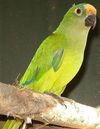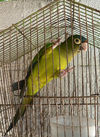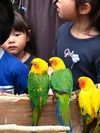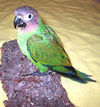Genus Aratinga
Blue-crowned Parakeet - Members of the genus Aratinga are officially called parakeets by the AOU and by birders, though usually called conures in aviculture.
Peach-fronted Parakeet - The Peach-fronted Parakeet , more commonly known as the Peach-fronted Conure in aviculture, is a species of parrot in the Psittacidae family. It is widespread and often common in semi-open and open habitats in eastern Brazil, Bolivia, Paraguay, far northern Argentina and southern Suriname . Both its common and scientific name is a reference to the orange-yellow forehead, although this is reduced in juveniles.
Golden-capped Conure - The Golden-capped Parakeet is a species of parrot in the Psittacidae family. It is found in Brazil and Paraguay. Its natural habitats are subtropical or tropical dry forests, subtropical or tropical moist lowland forests, dry savanna, and plantations. It is threatened by habitat loss.
Aratinga brevipes - The Socorro Parakeet is a species of parrot in the Psittacidae family. It is endemic to Socorro Island in the Revillagigedo Islands, Mexico. Its natural habitat is subtropical or tropical moist lowland forests. It is threatened by habitat loss due to feral sheep and predation by feral cats.
Caatinga Parakeet - The Caatinga Parakeet or Cactus Parakeet is a species of parrot in the Psittacidae family. It is endemic to the Caatinga region in north-eastern Brazil.
Orange-fronted Parakeet - There are three subspecies:
Hispaniolan parakeet - The bird is a medium-sized parakeet, evenly colored green, with a long and pointed tail, pale beak and legs, white eye-ring and red patch on the wing's wrist area. Sexes are identical; the bird is highly gregarious, forming flocks which can surpass several dozen individuals. The only similar bird in its native range is the possibly introduced Olive-throated Parakeet, from which it can be readily differentiated mainly by wing patches that are blue, instead of red.
Red-masked Conure - Red-masked Parakeets average about 33 cm long, of which half is the tail. They are bright green with a mostly red head on which the elongated pale eye-ring is conspicuous; the nape is green. Also, the lesser and median underwing coverts are red, and there is some red on the neck, the thighs, and the leading edge of the wings. Juveniles have green plumage, until their first red feathers appear at around the age of four months.
Cuban Conure - Its natural habitats are dry forests, dry savanna, and arable land. The species breeds seasonally, nesting from April to July. It nests in holes in trees or termite nests, particularly those created by the Cuban Green Woodpecker. Three to five eggs are incubated for around 22 days, and the nestling period is between 45–50 days. The species was once very common but is now much reduced due to habitat loss and trapping for the cagebird trade. As a consequence it is now listed as vulnerable by the IUCN.
Crimson-fronted Parakeet - The Finsch's Parakeet also called Finsch's Conure or Crimson-fronted Parakeet is a species of parrot in the Psittacidae family. It is found in Costa Rica, Nicaragua, and Panama. Its natural habitats are subtropical or tropical moist lowland forests and heavily degraded former forest.
Green Parakeet - The Pacific Parakeet, formerly considered a distinct species, is now placed herein as a subspecies Aratinga holochlora strenua.
Jandaya Parakeet - It was first described by German naturalist Johann Friedrich Gmelin in 1788.
Aratinga labati - Jean-Baptiste Labat described a population of small parrots living on Guadeloupe, which have been postulated to be a separate species based on little evidence. The were called Conurus labati, and are now called the Guadeloupe Parakeet . There are no specimens or remains of the extinct parrots. Their taxonomy may never be fully elucidated, and so their postulated status as a separate species is hypothetical.
White-eyed Parakeet - First described by German zoologist Philipp Ludwig Statius Müller in 1776, its specific epithet is derived from the Ancient Greek leukos "white" and ophthalmos "eye".
Mitred Parakeet - A relatively long-tailed species with a total length of 34–38 cm .
Brown-throated Parakeet - The Brown-throated Parakeet is mostly green, with the lowerparts being a lighter green than the upperparts. Black/grey beak. Some blue in the wing feathers. Brown throat. Head and face colours depend on the subspecies.
Aratinga rubritorquis - The Red-throated Parakeet , also called Red-throated Conure, is a species of parrot in the Psittacidae family. It is found in El Salvador, Guatemala, Honduras, and Nicaragua. Its natural habitats are subtropical or tropical dry forests and subtropical or tropical moist montanes.
Sun Parakeet - On average, Sun Parakeets weigh approximately 110 g and are around 30 cm long. They are sexually monomorphic.
Scarlet-fronted Parakeet - The Scarlet-fronted Parakeet or is a long-tailed South American species of parrot, which is sometimes called the Scarlet-fronted Conure or Wagler's Conure. It is found in Colombia, Ecuador, Peru, and Venezuela. Its natural habitats are subtropical or tropical dry forests, subtropical or tropical moist lowland forests, subtropical or tropical moist montanes, and especially high-altitude shrubland and forest; it is also known to visit heavily degraded former forest.
Dusky-headed Parakeet - This long-tailed species is generally green in color with a gray-brown head, a blue-tipped tail and remiges that are dark gray from below, mainly blue from above. The bill is black, and it has a broad bare white eye-ring. With an average length of 25–28 cm and a weight of about 100 grams, it is slightly smaller than the Sun Conure.











